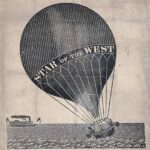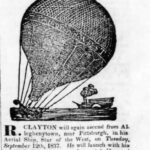The first attempt to deliver mail by air in Western Pennsylvania occurred in 1840, about 63 years before the Wright Brothers made their first flight.
Richard Clayton, a balloonist, took off from an amphitheater in Allegheny Town, now the North Side area of Pittsburgh, on May 4, 1840, to carry mail by “aerial packet” destined for Philadelphia.
The flight ended in failure over Tarentum, where newspapers at the time related that “something happened to the big gas envelope when he (Clayton) was about 20 miles from Pittsburgh and it dropped from the skies — on Tarentum — much to the consternation of the Tarentum-ites.”
In 1840, a man falling from the sky in a balloon would have been quite a spectacle. At the time, Native Americans still inhabited a portion of Tarentum. To them, it must have been akin to a UFO sighting.
Clayton emigrated from England to the United States in the early 1830s. He opened a silversmith and clock making shop in Cincinnati.
He had developed an interest in ballooning while in England. When he arrived in Ohio, he began constructing his airship, which he called the Star of the West. The balloon was 50 feet tall and was constructed from 4,500 square feet of silk. It could carry 1,000 pounds of payload.
His first ascent was April 8, 1835, in Cincinnati. He recouped his investment in the balloon by charging several thousand spectators 50 cents each to view his takeoff.
To garner more publicity, he took a small dog with him and dropped it by parachute safely to the ground from the balloon.
The flight lasted 9½ hours and established a world record for the longest balloon flight. He landed in Monroe County, Va. The community nearby still bears the name Clayton in his honor.
His second flight ended in a crash because of high winds. It destroyed the balloon.
The basket Clayton was in during the flight became detached, and he was rescued safely from the rooftop of a building.
His third flight, with a new balloon, took place July 4, 1835. He took letters with him attempting to be the first airmail pilot in the country.
He encountered freezing temperatures and leaks in the silk outer layer of the balloon that caused him to abandon his attempt about 100 miles from the launch point.
Although he didn’t reach his destination, he took the letters he was carrying to a local post office so they could be forwarded to their recipients. Clayton still received partial credit for the first airmail delivery in the United States.
Later that same year, while on another flight, the hydrogen gas in Clayton’s balloon exploded. He survived because the remaining portion of the silk outer shell of the balloon acted as a parachute for him.
On the day of a balloon flight, the public was admitted to the launch area about two hours before liftoff to observe the entire process of preparing the balloon for flight.
The balloon was filled with approximately 600 cubic feet of hydrogen gas. The highly explosive gas was generated on-site by the action of sulfuric acid on zinc in drums of water.
Just before liftoff, a small balloon was released to determine the wind direction at various altitudes. When the time was right, the cords that tethered the balloon to the ground were cut. Tickets to watch the balloon being prepared for takeoff cost 50 cents for adults and 25 cents for children.
On Sept. 12, 1837, Clayton performed his 14th aerial voyage, the second from Pittsburgh, and recorded his observations in a journal: “I took my departure from a densely crowded amphitheater in Alleghenytown (Pittsburgh’s North Side). … The ladies, as I ascended, displayed their approbation by waving their handkerchiefs, and the gentlemen expressed theirs by their loud and long continued acclamations, which was distinctly heard by me long after they had shrunk to mere insects in size. For a long time I was cheered as I passed along by hundreds of voices from beneath, for as those from the amphitheater died away, others sprang from the pleasure yachts and the numerous boats on the Allegheny River from the greater eastern part of Pittsburgh.”
The amphitheater on the North Side became known as the Balloon Amphitheater in the mid-1800s.
Transporting the balloon between flights was a major problem for Clayton. He frequently used canal boats, stage coaches and riverboats. The railroad did not exist in the region until the 1860s.
In the 1840s, Clayton gave up ballooning and returned to his work as a silversmith and clock maker. He died in 1878 at the age of 67.
On Oct. 4, 1913, 83 years after Clayton arrived in Tarentum in his balloon, the first successful airmail flight in Western Pennsylvania was flown from Natrona Heights Field to Oakmont. The pilot, Theodore Stockman, was carrying letters dispatched from the Natrona post office.













